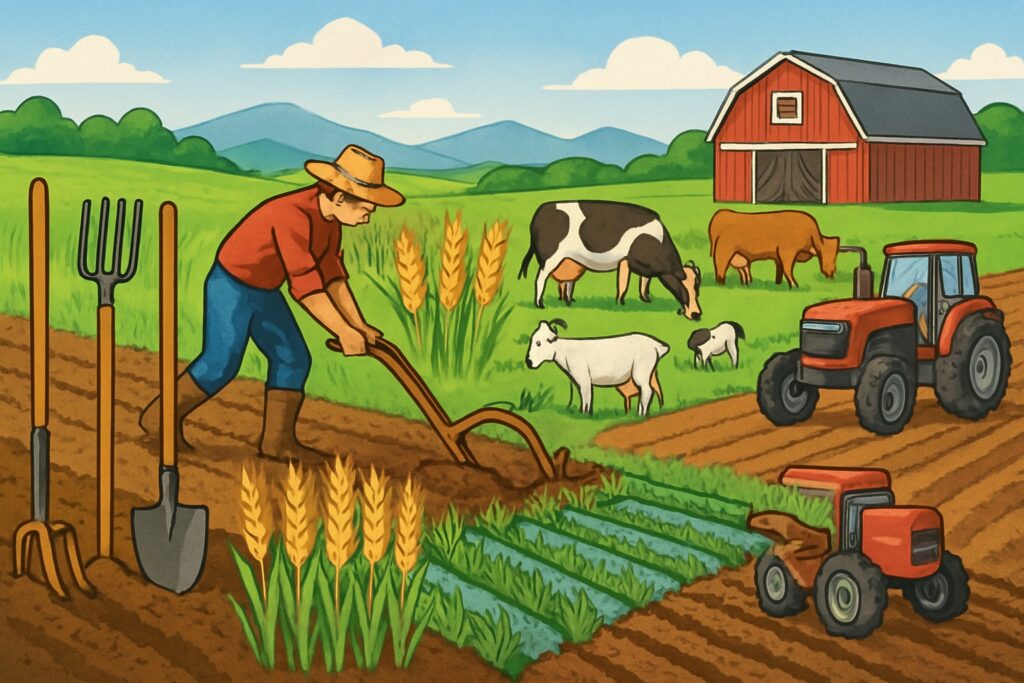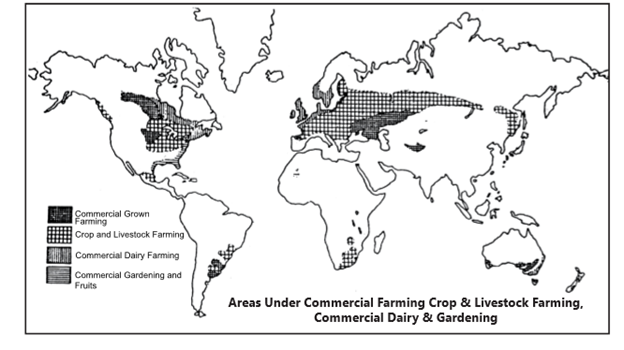World agriculture can be categorized into various types based on factors like: climate, farming practices, and economic aspects. Agriculture is the practice of cultivating soil, growing crops, and raising animals for food, fiber, and other human needs. It is one of the oldest and most fundamental economic activities, forming the backbone of food security and rural economies worldwide.

Derwent Whittlesey, an American geographer, proposed one of the most comprehensive and widely accepted typologies of world agricultural regions in 1936. He identified 13 major agricultural regions based on physical environment, farming practices, crops grown, and economic development.
Table of Contents
Importance of Agriculture
- Primary livelihood for millions globally, especially in developing countries.
- Source of food, raw materials (cotton, rubber, sugar), and industrial inputs.
- Contributes to GDP and employment in many countries.
- Basis for rural development and socioeconomic transformation.
Types of Agriculture
Agricultural systems vary based on climate, culture, technology, and economic development.
1. Subsistence Agriculture
- Purpose: Grown mainly for family consumption.
- Regions: Africa, South Asia, parts of Latin America.
- Features: Low productivity, small plots, traditional tools.
2. Commercial Agriculture
- Purpose: Grown for sale in markets (domestic or export).
- Regions: USA, Canada, Europe, Australia.
- Features: Mechanized, high-input, large-scale.
3. Shifting Cultivation
- Practiced in tropical forest regions.
- Involves clearing and burning vegetation (slash and burn).
- Land is farmed briefly then left fallow.
4. Plantation Agriculture
- Large estates focused on a single cash crop (e.g., tea, coffee, rubber).
- Found in tropical regions, often export-oriented.
5. Mixed Farming
- Combination of crop cultivation and livestock.
- Provides economic stability and diversified income.
6. Pastoralism
- Herding of animals, either nomadic or settled.
- Found in arid and semi-arid regions.
7. Intensive vs. Extensive Farming
- Intensive: High input and output per unit area (e.g., rice in Asia).
- Extensive: Low input and output spread over large areas (e.g., wheat farming in Canada).
Major Agricultural Regions of the World
- Monsoon Asia: Rice cultivation.
- North America: Wheat, maize, commercial livestock.
- Mediterranean: Grapes, olives, citrus.
- Europe: Mixed farming, dairy.
- Tropical Africa: Subsistence farming, cocoa, coffee.
- Latin America: Sugarcane, bananas, soybeans.

Derwent Whittlesey’s Classification of Agricultural Regions
Derwent Whittlesey, an American geographer, proposed one of the most comprehensive and widely accepted typologies of world agricultural regions in 1936. He identified 13 major agricultural regions based on physical environment, farming practices, crops grown, and economic development.
These regions are divided into two broad categories:
A. Six Agricultural Regions in Developed Countries
-
Dairying
-
Location: Northeastern USA, Northwestern Europe, New Zealand.
-
Focus: Milk and dairy products.
-
Features: Located near urban markets due to perishability.
-
-
Mixed Crop and Livestock Farming
-
Location: Midwest USA, parts of Europe.
-
Crops: Corn, soybeans.
-
Livestock: Cattle, pigs.
-
Integrated: Crops feed animals, animals provide manure.
-
-
Grain Farming
-
Location: USA (Great Plains), Canada, Russia, Australia.
-
Main Crops: Wheat, barley.
-
Highly mechanized and commercial.
-
-
Livestock Ranching
-
Location: Western USA, Argentina, Australia, Central Asia.
-
Extensive: Large land, low labor.
-
Animals: Cattle, sheep.
-
-
Mediterranean Agriculture
-
Location: Mediterranean Basin, California, Chile, South Africa, SW Australia.
-
Crops: Grapes, olives, citrus.
-
Features: Dry summers, wet winters.
-
-
Commercial Gardening and Fruit Farming (Truck Farming)
-
Location: USA (Southeast), Europe.
-
Products: Vegetables, fruits.
-
Market-oriented, high input.
-
B. Seven Agricultural Regions in Developing Countries
-
Shifting Cultivation
-
Location: Tropical forests of Africa, Southeast Asia, Amazon.
-
Practice: Slash and burn.
-
Crops: Yam, cassava, millets.
-
-
Pastoral Nomadism
-
Location: North Africa, Middle East, Central Asia.
-
Livestock: Camels, goats, sheep.
-
Features: Mobility, harsh climates.
-
-
Intensive Subsistence Agriculture (Wet Rice Dominant)
-
Location: East, South, Southeast Asia.
-
Main Crop: Rice.
-
Labor-intensive, small plots.
-
-
Intensive Subsistence Agriculture (Not Wet Rice)
-
Location: Interior India, Northeast China.
-
Crops: Wheat, barley, millets.
-
Often found in drier or colder regions.
-
-
Plantation Farming
-
Location: Latin America, Africa, Southeast Asia.
-
Crops: Tea, coffee, sugarcane, bananas.
-
Export-oriented, often monoculture.
-
-
Commercial Grain-Livestock Farming (Transitional areas)
-
Seen in developing areas approaching commercial farming.
-
-
Sparse or No Agriculture
-
Location: Deserts, Arctic.
-
Reasons: Harsh climate, poor soil.
-
Significance of Whittlesey’s Classification
-
Helps understand spatial patterns of agriculture globally.
-
Useful for comparing traditional vs. modern farming.
-
Reflects the role of climate, culture, and economy in shaping agriculture.
Challenges in World Agriculture
- Climate change and weather extremes.
- Soil degradation and overuse of land.
- Water scarcity.
- Unequal access to technology and land.
- Global trade policies and price volatility.
Modern Trends in Agriculture
- Green Revolution: Use of high-yield varieties and chemical inputs.
- Organic farming: Eco-friendly and sustainable.
- Precision farming: Use of GPS, sensors, and data.
- Agroforestry and climate-smart agriculture.
- Growing role of agri-business and global supply chains.
Conclusion
World agriculture is highly diverse, shaped by environmental, technological, and socioeconomic factors. While it continues to feed billions, sustainable and equitable practices are essential to meet the challenges of the future.
Read: Geography Notes